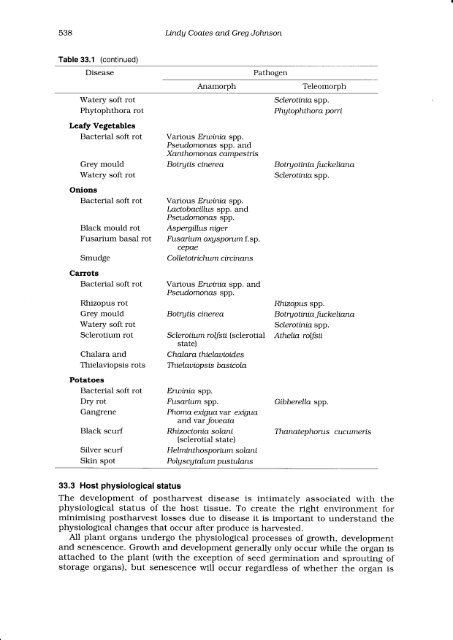POSTHARVEST DISEASES OF FRUIT AND VEGETABLES Lindy ...
POSTHARVEST DISEASES OF FRUIT AND VEGETABLES Lindy ...
POSTHARVEST DISEASES OF FRUIT AND VEGETABLES Lindy ...
Create successful ePaper yourself
Turn your PDF publications into a flip-book with our unique Google optimized e-Paper software.
538<br />
Ltndg Coates and Greg Johnson<br />
Table 33.1 (continued)<br />
Disease<br />
Pathogen<br />
Anamorph<br />
Teleomorph<br />
Watery soft rot<br />
Phytophthora rot<br />
Leafy Vegetables<br />
Bacterial soft rot<br />
Grey mould<br />
Watery soft rot<br />
Onions<br />
Bacterial soft rot<br />
Black mould rot<br />
Fusarium basal rot<br />
Smudge<br />
Carrots<br />
Bacterial soft rot<br />
Rhizopus rot<br />
Grey mould<br />
Watery soft rot<br />
Sclerotium rot<br />
Chalara and<br />
Thielaviopsis rots<br />
Potatoes<br />
Bacterial soft rot<br />
Dry rot<br />
Gangrene<br />
Black scurf<br />
Silver scurf<br />
Skin spot<br />
Various Eruinia spp.<br />
Pseu.domonas spp. and<br />
Xantho monas campes trrs<br />
Botrytis cinerea<br />
Various Eruinia spp.<br />
LactobaciLltts spp. and<br />
Pseu.domonas spp.<br />
Aspergillus niger<br />
Flts arium orqsporum f. sp.<br />
cepae<br />
C olle totrtchum cir cinans<br />
Various Ertuinia spp. and<br />
Pseudomonas spp.<br />
Botrgtis ctnerea<br />
S cler otium r otJs ii ( s c lero tia-l<br />
state)<br />
Chal.ar a thietauioid-e s<br />
Thielautop s is b asicola<br />
Erurnia spp.<br />
FLsanum spp.<br />
Phoma exiguavar exigua<br />
andvar Joueata<br />
Rhizoctonta solani.<br />
(sclerotial state)<br />
H elmtntho s p ortum solani<br />
P olg s cg talum pus tulans<br />
Sclerotrnra spp.<br />
Phgtopttthora porri<br />
BotryotintaJtrckeltana<br />
Scterofinra spp.<br />
Rhrzoplrs spp.<br />
BotryottntaJuckeliana<br />
Sclerohnia spp.<br />
Athelin rolfsii<br />
Gibberella spp.<br />
Thanatephorus cucumerb<br />
33.3 Host physiological status<br />
The development of postharvest disease is intimately associated with the<br />
physiological status of the host tissue. To create the right environment for<br />
minimising postharvest losses due to disease it is important to understand the<br />
physiological changes that occur after produce is harvested.<br />
All plant organs undergo the physiological processes of growth, development<br />
and senescence. Growth and development generally only occur while the organ is<br />
attached to the plant (with the exception of seed germination and sprouting of<br />
storage organs), but senescence will occur regardless of whether the organ is







![[Compatibility Mode].pdf](https://img.yumpu.com/27318716/1/190x135/compatibility-modepdf.jpg?quality=85)









